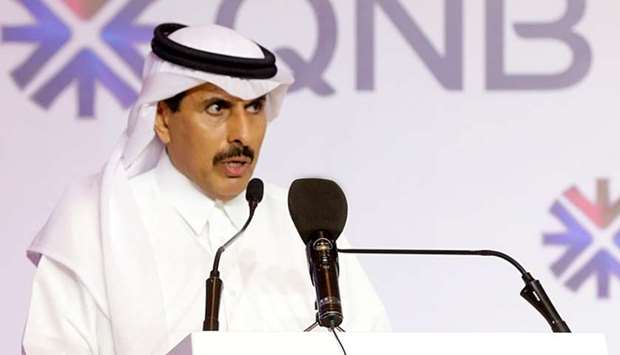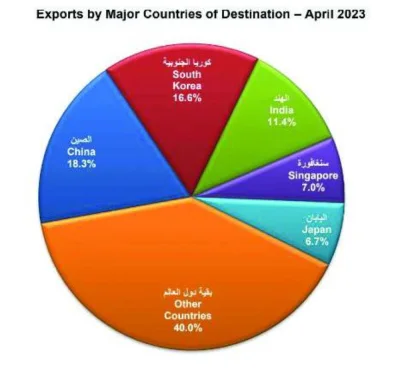Qatar has managed to achieve a budget surplus of QR7.1bn in the first six months of 2018 amid an ongoing economic blockade, HE the Governor of Qatar Central Bank (QCB) Sheikh Abdullah bin Saoud al-Thani.
Sheikh Abdullah announced the achievement in a speech at Monday’s Euromoney Qatar Conference 2018, adding that in 2017, Qatar had a deficit amounting to QR35.4bn.
“Thanks to the wise leadership and concerted efforts of all bodies and sectors in the country, the crisis has been overcome and the negative effects of the unjust siege have been addressed. Today, Qatar is stronger than ever, and its economy is stronger than before June 5, 2017,” he said.
Citing “great indicators,” the QCB governor said Qatar’s real GDP grew by 2.5% in H1 2018 against 1.6% last year. Nominal GDP for the same period was up 14.6%, “with inflation continuing at a low level of only 1%, which was positively reflected in improving internal and external balances,” he said.
The current account of the balance of payments in the first half of 2018 saw a QR25.7bn surplus or 7.6% of Qatar’s GDP compared to the 1.5% or QR4.5bn surplus recorded in the same period in 2017.
In the first few months of the siege, Qatar’s international reserves and foreign currency liquidity dropped by 20% but have recovered “and are now back to normal,” amounting to QR46.5bn by end of September 2018, “a level higher before the imposition of the unjust siege when it was $45.7bn at the end of May 2017.”
Sheikh Abdullah said the precautionary measures taken by the QCB to enhance the flexibility and development of the financial system, as well as the regulatory and international requirements of the Basel Committee and the Accounting and Auditing Organisation for Islamic Financial Institutions have contributed to the flexibility of the financial sector.
On the other hand, the monetary policy taken by the QCB under the unjust siege led to effective management of this crisis, which reflected positively on the banking and financial sector, he continued.
This was illustrated by several indicators as the total assets of Qatar-based commercial banks grew by 5% in the first nine months of 2018. In terms of pooled savings, customer deposits with commercial banks have increased to more than 2.5% until September 2018, Sheikh Abdullah said.
On domestic employment, the QCB governor said credit facilities extended by commercial banks to their customers have increased by 1.8% by September this year. The capital adequacy ratio of banks operating in Qatar increased to more than 15.5% at the end of September 2018.
“In addition, the ratio of non-performing loans to total loans and credit facilities stood at 1.7%, reflecting the quality of the assets of the commercial banks operating in the country at the end of September 2018.
“Net profits/average shareholders’ equity amounted to about 11.6% at the end of September 2018. The total assets were around 1.2% at the end of September 2017, and the liquidity coverage ratio of national banks was about 140% at the end of August 2018, and for the total banks operating in Qatar during the same period reached 142% in 2017,” he said.
During the siege, Sheikh Abdullah said the QCB increased the strength and efficiency of Qatar’s financial sector, and at the end of 2017, it launched the second strategic plan for the financial sector 2017-2022, in coordination with Qatar Stock Exchange and QFC Regulatory Authority.
The strategy is developing a roadmap on strengthening financial sector control and financial market development, as well as maintaining integrity and trust in the financial system.
He said Qatar is currently preparing for the launch of the well-known Financial Technology (Fintech) strategy, as well as the launch of the National Strategy for Inclusion & Financial Education at the state level.
“Thanks to the wise leadership and concerted efforts of all bodies and sectors in the country, the crisis has been overcome and the negative effects of the unjust siege have been addressed. Today, Qatar is stronger than ever, and its economy is stronger than before June 5, 2017,” he said.
Citing “great indicators,” the QCB governor said Qatar’s real GDP grew by 2.5% in H1 2018 against 1.6% last year. Nominal GDP for the same period was up 14.6%, “with inflation continuing at a low level of only 1%, which was positively reflected in improving internal and external balances,” he said.
The current account of the balance of payments in the first half of 2018 saw a QR25.7bn surplus or 7.6% of Qatar’s GDP compared to the 1.5% or QR4.5bn surplus recorded in the same period in 2017.
In the first few months of the siege, Qatar’s international reserves and foreign currency liquidity dropped by 20% but have recovered “and are now back to normal,” amounting to QR46.5bn by end of September 2018, “a level higher before the imposition of the unjust siege when it was $45.7bn at the end of May 2017.”
Sheikh Abdullah said the precautionary measures taken by the QCB to enhance the flexibility and development of the financial system, as well as the regulatory and international requirements of the Basel Committee and the Accounting and Auditing Organisation for Islamic Financial Institutions have contributed to the flexibility of the financial sector.
On the other hand, the monetary policy taken by the QCB under the unjust siege led to effective management of this crisis, which reflected positively on the banking and financial sector, he continued.
This was illustrated by several indicators as the total assets of Qatar-based commercial banks grew by 5% in the first nine months of 2018. In terms of pooled savings, customer deposits with commercial banks have increased to more than 2.5% until September 2018, Sheikh Abdullah said.
On domestic employment, the QCB governor said credit facilities extended by commercial banks to their customers have increased by 1.8% by September this year. The capital adequacy ratio of banks operating in Qatar increased to more than 15.5% at the end of September 2018.
“In addition, the ratio of non-performing loans to total loans and credit facilities stood at 1.7%, reflecting the quality of the assets of the commercial banks operating in the country at the end of September 2018.
“Net profits/average shareholders’ equity amounted to about 11.6% at the end of September 2018. The total assets were around 1.2% at the end of September 2017, and the liquidity coverage ratio of national banks was about 140% at the end of August 2018, and for the total banks operating in Qatar during the same period reached 142% in 2017,” he said.
During the siege, Sheikh Abdullah said the QCB increased the strength and efficiency of Qatar’s financial sector, and at the end of 2017, it launched the second strategic plan for the financial sector 2017-2022, in coordination with Qatar Stock Exchange and QFC Regulatory Authority.
The strategy is developing a roadmap on strengthening financial sector control and financial market development, as well as maintaining integrity and trust in the financial system.
He said Qatar is currently preparing for the launch of the well-known Financial Technology (Fintech) strategy, as well as the launch of the National Strategy for Inclusion & Financial Education at the state level.




